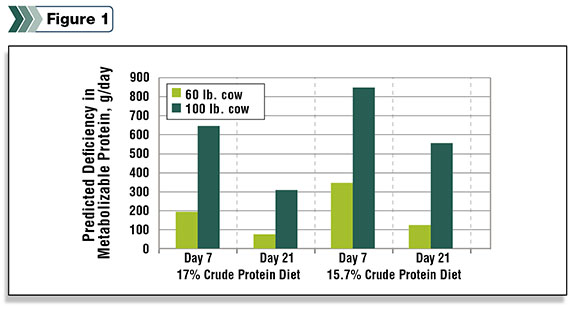The transition period for dairy cows is often defined as three weeks prior to calving until three weeks after calving. During this time, the cow experiences dramatic changes in feed intake, nutritional requirements and physiological status that affect nutrient balances, milk yield and composition, health and reproductive performance.
Most transition cow research has focused on nutrition during the “close-up” period or final three weeks of pregnancy; the assumption being diets fed during this period of time will have carryover effects on the next lactation.
However, during the late stages of gestation, the nutrient requirements for maintenance, growth and pregnancy are quite low and are easily met, with the possible exception of the few days before calving when intake may drop.
In contrast, during the post-fresh transition period, the cow’s nutrient requirements are not met for a prolonged period of time because of low feed intakes relative to nutrient requirements to support lactation.
Perhaps we have focused too much of our energies, both in research and practice, on the dry period and not enough on nutrition of the post-fresh transition cow?
This is not to say that dry cow nutrition is not important, but when problems occur, perhaps we are too quick to scrutinize dry cow diets while neglecting close examination of diets being fed to fresh cows.
Unfortunately, there is a paucity of research on post-fresh transition cows. Cow variation is high during this time, which means that experiments require large numbers of cows to detect significant treatment effects.
Additionally, cows may be lost from experiments due to the challenges of this period and universities tend not to have large enough herds to supply sufficient animals for adequate replication.
Consequently, most nutrition research on early-lactation cows begins at four to five weeks post-calving, which is too late because the period of extreme nutrient deficits are over by that time. This brings us to the question: What do we know about fresh cow energy and protein nutrition?
Energy
- I ssues and questions – Negative energy balances of 10 Mcal NEl per day or greater are common; the lowest point usually occurs between 10 to 18 days postpartum and positive energy balance is reached on average by 45 days postpartum.
How do we try to meet the cow’s energy demands during this critical time? Should cows be fed a post-fresh transition diet prior to receiving a high-group totally mixed ration (TMR)? Should that diet contain straw? Perhaps some baled hay should be fed?
Does this decision depend on the diet fed pre-fresh? Does starting cows on a high-group TMR immediately after calving “push” them too hard and result in greater displaced abomasums, acidosis and severe negative energy balance leading to fatty liver, ketosis and poor health and reproduction?
Conversely, does diluting energy density by feeding straw or other low-quality roughages postpartum restrict energy intake and exacerbate negative energy balance?
What about the hepatic oxidation theory (HOT) which speculates that post-fresh diets can be too fermentable and result in excessive propionate production that might ultimately result in depressed feed intakes?
- Research findings – From the limited amount of research available, it appears that early-lactation cows respond with more milk production when energy density of the diet is increased by increasing nonfiber carbohydrate (NFC) and decreasing neutral detergent fiber (NDF).
Other strategies to increase energy availability to the early-postpartum cow (e.g., increase starch content, increase starch fermentability, increase NDF digestibility) have not had negative effects on intake or lactation performance and in many cases have had positive effects.
Currently, early-postpartum transition cow trials examining diets with differing capacities to produce propionate in the rumen do not provide sufficient evidence to support implementation of HOT.
One exception is a trial in which lowering starch content for the first 21 days postcalving, while maintaining NEl per kg dry matter, improved feed intake and milk yield. Interestingly, cows on this trial came off “controlled” energy diets prepartum (i.e., relatively high-fiber diets with no adaptation to grain prior to calving).
Some may argue that with increasing use of low-energy diets for the entire dry period and the absence of a pre-fresh transition diet, there should be a post-fresh transition diet; however, this hypothesis has not been tested in a research trial.
The studies cited above did not have sufficient replication to assess diet effects on health and reproduction. Consequently, important questions regarding postpartum energy feeding remain.
With the caveat that more research is needed, at this time there is little evidence that we should “hold back” cows and feed them a lower-energy-density diet immediately postpartum before moving them onto a “high-group” diet.
Please note that all the research trials cited above employed a TMR; therefore, conclusions from these studies may not apply when feeding management deviates from that (e.g., feeding concentrates separate from forage).
Protein
- Issues and questions – Similar to energy, protein intake during the first three weeks post-calving will be insufficient to meet requirements for milk production due to low feed intake. The cow responds to this by mobilizing protein, but the amount is not sufficient to meet requirements.
Although the National Research Council (NRC) provides an estimate of how much protein the cow mobilizes with bodyweight loss, it does not specify how much of the reserve is oxidized for energy, is converted to glucose or serves as an amino acid precursor for milk protein synthesis. I
n fact, when the NRC estimates bodyweight loss to support lactation, it assumes the mobilized protein is being used as energy. In contrast to energy, density of protein in the diet can be increased without serious negative effects on rumen fermentation.
If protein content of the post-fresh diet is increased and is no longer a bottleneck for milk production, how will the cow respond? Will energy become limiting such that the cow will not respond? Will she mobilize more fat to facilitate greater milk production?
Perhaps she will increase intake? Because of financial and environmental concerns, there is increasing pressure to decrease crude protein in diets fed to lactating cows. Is this a wise feeding strategy for post-fresh transition cows?
- Research findings – Despite the paucity of research data examining protein feeding during the first three weeks postpartum, a strong case can be made for not shortchanging cows on protein or amino acids during this period.

Figure 1 shows the potential for a negative metabolizable protein (MP; i.e., protein absorbed into the bloodstream) balance for cows producing 60 or 100 lbs milk per day at seven or 21 days postpartum.
Two different postpartum diets were evaluated using the NRC, one with 15.7 percent crude protein (CP) and the other with 17.0 percent CP.
Rumen-degradable protein (RDP) content of the diets was adequate. The NRC provided estimates for dry matter intake (DMI) and MP balance.
Assuming NRC predictions are correct, the diets will not provide sufficient MP. As time postpartum increases, cows will gradually achieve MP balance due to increased feed and protein intake relative to protein requirements.
Prior to that, cows are likely to be in a negative MP balance and the likelihood is greater with higher levels of production. Consequently, the cow will either eat more feed than predicted by NRC, mobilize protein to support lactation or milk production will be limited below the inputs (60 or 100 lbs) used for this NRC simulation.
Most studies examining protein or amino acid supplementation of early-lactation cows have started treatments beyond the post-fresh transition period. In some studies, treatments started prepartum and continued postpartum.
Interpretation of results from these studies is difficult because any positive effects of increasing protein feeding postpartum may have been offset by feeding too much protein prepartum.
An excellent study from Denmark indicated that providing additional MP by postruminal infusion of casein during the first four weeks postpartum (360 g on day 1 postpartum, 720 g on day 2 postpartum and then gradually decreasing to 194 g per day by day 29 postpartum) increased milk yield 16 lbs per day.
As mentioned above, alleviation of MP deficits in just fresh cows may cause energy to become first limiting. In this study, cows did not respond to abomasal infusion of protein by increasing feed intake.
Instead, fatty acid mobilization from adipose tissue was increased as indicated by increased nonesterified fatty acid concentration in blood. Feeding rumen-protected amino acids may be a strategy to help meet amino acid requirements and create space in the diet to help meet the cow’s energy requirements.
Because of high cost of supplemental protein and environmental concerns with overfeeding protein, there is increasing pressure to scale back the percentage of CP in dairy diets; however, there may be danger in extrapolating this approach to immediate post-fresh cows that are deficient in MP.
One possible way to alleviate this problem is to consider creating an immediate post-fresh group (less than 21 days in milk) to feed diets that increase delivery of MP during this critical time period.
Focus on providing sufficient amounts of RDP and fermentable carbohydrates to stimulate microbial protein production, feed high-quality RUP sources and consider rumen-protected amino acids to more efficiently meet the lysine and methionine requirements of the animal. PD
Grummer is an emeritus professor with the Department of Dairy Science at the University of Wisconsin – Madison . Ordway is a technical services specialist with Balchem Corporation .
References omitted due to space but are available upon request. Click here to email an editor.

-
Ric Grummer
- Ruminant Technical Director
- Balchem Corporation
- Email Ric Grummer






